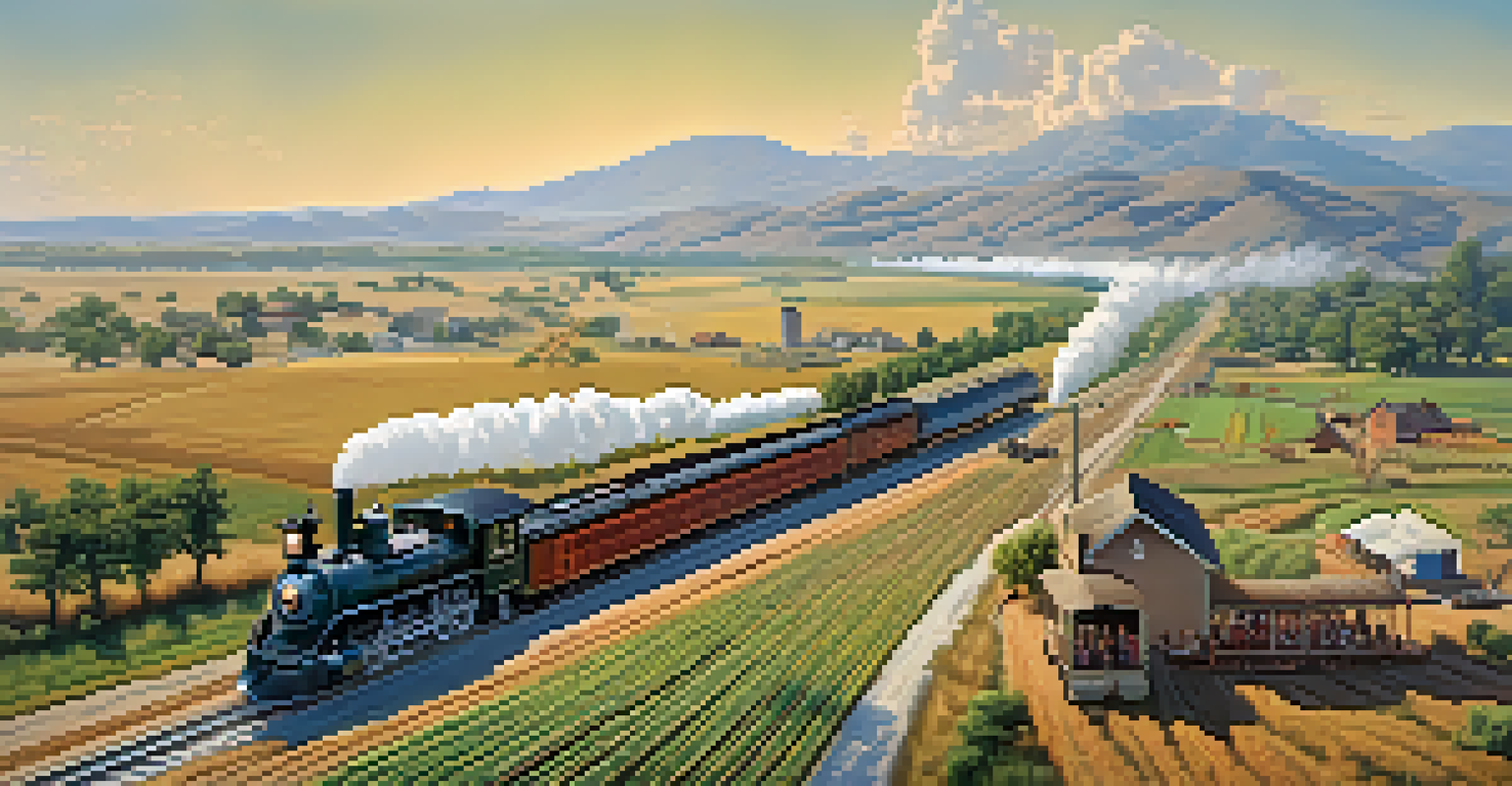Key Figures in California's Railroad History: A Closer Look

The Visionary Behind the Transcontinental Railroad
One of the most significant figures in California's railroad history is Theodore Judah. As a civil engineer, Judah was instrumental in the planning and construction of the Central Pacific Railroad, which played a pivotal role in linking the East and West coasts of the United States. His vision of a transcontinental railroad was initially met with skepticism, but his tenacity eventually won over investors and politicians alike.
The railroad is a great equalizer. It opens up opportunities to all, regardless of background.
Judah's passion for the project was evident as he traversed the Sierra Nevada mountains, surveying potential routes. He faced numerous challenges, including harsh weather conditions and political opposition, yet his unwavering commitment helped pave the way for the railroad's construction. His efforts not only transformed California's economy but also fostered a national connection that would change the course of American history.
Tragically, Judah's life was cut short before he could see the completion of the railroad he dreamed of. However, his legacy lived on through the railroad's eventual success, and he is remembered as a pioneer whose vision was crucial in creating the infrastructure that would support California's growth.
Leland Stanford: A Railroad Tycoon and Governor
Leland Stanford was not just a key player in California's railroad development; he was also a prominent political figure. As one of the 'Big Four,' which included Judah, Stanford played a significant role in the founding of the Central Pacific Railroad. His business acumen and political connections allowed him to navigate the complexities of railroad financing and regulation.

Stanford's influence extended beyond the railroad industry as he served as California's governor from 1862 to 1863. His tenure was marked by efforts to promote infrastructure development, and he used his position to advocate for the railroad's expansion. Stanford's vision was not only about transportation; he aimed to improve trade and communication across the state.
Judah's Vision Transformed America
Theodore Judah's pioneering work on the Central Pacific Railroad was crucial in connecting the East and West coasts, despite facing significant challenges.
In addition to his contributions to the railroad, Stanford's legacy includes the establishment of Stanford University, which he founded in memory of his son. This institution has become a beacon of education and innovation, further highlighting Stanford's lasting impact on California's development.
Collis Potter Huntington: The Master Builder
Collis Potter Huntington was another key figure in California's railroad history, known for his role as a businessman and railroad executive. As a member of the 'Big Four,' Huntington played an essential role in constructing the Central Pacific Railroad. His strategic thinking and investment strategies helped to secure funding and resources necessary for the railroad's expansion.
The legacy of any great project is measured by the lives it touches and the progress it inspires.
Huntington's leadership was characterized by his ability to negotiate with powerful interests and navigate the political landscape. He understood the importance of building alliances, which helped him secure crucial agreements for land and funding. His efforts were instrumental in overcoming the many obstacles faced during the railroad's construction, including labor shortages and financial difficulties.
Beyond railroads, Huntington was also involved in various other industries, including shipping and utilities. His far-reaching influence and business ventures contributed significantly to California's economic landscape, leaving a legacy that extended well beyond the tracks.
The Role of Chinese Laborers in Railroad Construction
While key figures like Judah, Stanford, and Huntington often receive the spotlight, it's important not to overlook the contributions of Chinese laborers in the construction of California's railroads. After the Gold Rush, many Chinese immigrants sought work to support their families, and railroad construction offered a vital opportunity. They played a crucial role in the Central Pacific Railroad's completion, especially in the treacherous Sierra Nevada region.
These laborers faced extreme conditions, working long hours in hazardous environments for minimal pay. Despite the challenges, their resilience and determination were vital in overcoming the physical obstacles of the mountainous terrain. The work they did was not only essential to the railroad's success but also laid the groundwork for California's future economic expansion.
Chinese Laborers Made It Possible
The contributions of Chinese laborers were essential in constructing California's railroads, often under harsh conditions and for minimal pay.
The legacy of Chinese workers is often overlooked in mainstream narratives. However, their contributions are an essential part of California's railroad history, reminding us that progress is often built on the backs of those who labor tirelessly behind the scenes.
The Impact of the Railroad on California's Economy
The completion of the transcontinental railroad had a profound impact on California's economy, transforming it from a remote region into a bustling economic hub. By facilitating the movement of goods and people, the railroad opened up new markets and opportunities for trade. This expansion stimulated industries such as agriculture, mining, and manufacturing, fueling the state's growth.
With the railroad in place, agricultural products from the Central Valley could be shipped to markets across the country, leading to a boom in farming. Similarly, the mining industry benefitted greatly, as supplies and labor could be transported more efficiently. The influx of goods and services led to urbanization, resulting in the rapid growth of cities like San Francisco and Los Angeles.
Moreover, the railroad also played a crucial role in attracting immigrants and settlers to California. As people learned about the opportunities available in the Golden State, they flocked westward, further contributing to the state’s diverse population and dynamic economy. The railroad, therefore, was not just a means of transportation; it was a catalyst for California's transformation.
Challenges Faced by California's Railroads
Despite its significant impact, California's railroad history was not without its challenges. From natural disasters to financial crises, the railroad industry faced numerous obstacles that threatened its existence. Earthquakes, floods, and landslides posed risks to the tracks and infrastructure, requiring constant maintenance and repair.
Additionally, financial difficulties were a recurring issue. The Great Depression, for example, led to decreased demand for rail services, resulting in bankruptcies and consolidation among railroad companies. These economic challenges forced many railroads to adapt to survive, often leading to reduced services or abandoned lines in less profitable areas.
Railroads Fueled Economic Growth
The completion of the transcontinental railroad transformed California's economy by facilitating trade, agriculture, and immigration.
Moreover, competition from other modes of transportation, like automobiles and airplanes, further complicated the landscape. As highways expanded and air travel became more accessible, railroads had to find innovative ways to remain relevant in an ever-evolving transportation market. These challenges shaped the railroad industry's history, leading to a gradual transformation of how goods and people traveled across California.
The Legacy of California's Railroad Pioneers
The legacy of California's railroad pioneers is a testament to their vision and determination. Their efforts not only shaped the transportation infrastructure of the state but also played a significant role in the broader narrative of American expansion. The stories of figures like Judah, Stanford, and Huntington remind us of the importance of innovation and collaboration in overcoming challenges.
As we look at the impact of the railroads today, we see a lasting influence on California's economy and culture. The railroads paved the way for the state's growth into a technological and economic powerhouse. They established a framework for transportation that continues to evolve, as modern rail systems adapt to the needs of a growing population.

Moreover, the history of California's railroads serves as a reminder of the diverse contributions made by individuals from various backgrounds. From laborers to executives, each played a role in creating the complex tapestry of California's railroad history, showcasing the collaborative spirit that continues to drive progress in the state.